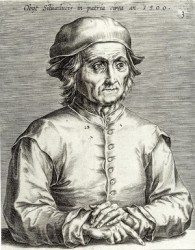
Gibson 1973d
“Hieronymus Bosch and the Dutch tradition” (Walter S. Gibson) 1973
[in: J. Bruyn e.a. (ed.), Album Amicorum J.G. van Gelder. Martinus Nijhoff, The Hague, 1973, pp. 128-131]
[Also mentioned in Gibson 1983: 43 (D10)]
The place of Bosch in the context of fifteenth-century Netherlandish painting is difficult to define. Of course, it cannot be denied that Bosch shows many contacts with artists active in Brabant and Flanders, but he also exhibits many affinities with the Northern Netherlands (see for example Geertgen tot Sint Jans, the Master of the Virgo inter Virgines and the Dutch fifteenth-century miniaturists), especially in his early works. Gibson gives examples of these affinities in Bosch’s Philadelphia Epiphany, in the Frankfurt and Boston Ecce Homo panels, in the Vienna Carrying of the Cross and in the St. Germain-en-Laye Conjuror (likely a faithful copy).
The relationships between Bosch and the Dutch miniaturists are not confined to his early period but can be found in his later work as well. This persistent influence suggests that Bosch may have received at least part of his early training in the workshop of an illuminator, perhaps at Utrecht. It is evident that his early paintings derive much more from the art of the Northern Netherlands than they do from the more refined, courtly styles practised in the southern provinces. The Dutch illuminators for example transmitted to Bosch many of the so-called archaizing elements discernible in his work.
[explicit 28th April 2013]